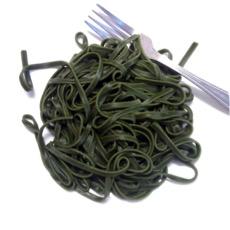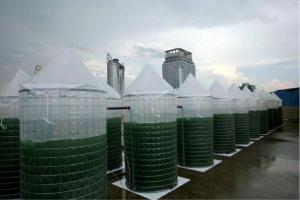By Jordan Gaal
AUSTIN, Texas — It’s salty, yet subtle, green, and crunchy. It has more calcium than milk, more potassium than a banana, and more iron than beef. And with new technologies that speed its transition from a health supplement to a widely accepted food, microalgae could play a critical role in feeding a rapidly expanding global population.The world will have to feed 2 billion more people by 2060 by producing a staggering 70 percent more food. Three researchers studying microalgae explained why these tiny photosynthetic cells could be the solution during a Feb. 18 session at the American Association for the Advancement of Science (AAAS) annual meeting.
Algae are a broad category, including single-celled organisms that harvest the sun’s energy and turn it into oils, proteins, and carbohydrates. Growing them in a bioreactor — a tank-like apparatus where the complex biological processes of algal growth are optimized — can result in zero waste and limited land and water use, unlike traditional food production. Smaller-scale production compared with commodity crops leads to challenges such as low efficiency and high investment costs. But if the technology for scaling up production and increasing efficiency can be developed, algae have the potential to be integrated into food sources worldwide.
If current consumption patterns continue, in just over 40 years the food system will support a mere 5.4 billion people – much less than today’s population, according to the United Nations Food and Agriculture Organization and the Institute of Food, Nutrition, and Health at the ETH Zurich university.
“We need to rethink our food system and need to significantly innovate,” said Alexander Mathys, a food technologist at the Institute of Food, Nutrition, and Health. “We need to team up to tackle such big challenges.”
Putting those words into action, Mathys and others are exploring ways to increase the efficiency of growing algae as food.
Just like turning up the heat on a stove, Mathys has developed a system that measures different nutrients at increasing temperatures. The process extracts proteins first, which are the most sensitive to heat. More intense heat extracts the lipids and antioxidants, which are less heat sensitive. Such information can help fine-tune algae as a food source that provides the nutrition particular to communities’ needs.
To determine the actual operating cost to produce one kilogram of algae, researchers have developed a system that determines patterns of electricity use, light intensity, and social factors, such as attitudes towards eating algae and demand for foods grown by local farmers. Maria Barbosa, director of AlgaePARC, a multidisciplinary research program, and microalgae biotechnologist at Wageningen University in the Netherlands, led this effort.“It is a tool to look at what are the patterns that most impact in order to create a viable process,” she said.
Advances are being made in bioreactor design as well. Algal growth requires several key inputs: water, sunlight, nutrients, and carbon dioxide. In traditional designs like algae pools, evaporation and precipitation affect water levels. And pools can’t be moved in response to seasonal changes in sunlight.
Tube-shaped bioreactors control evaporation and are mobile but may be inefficient if carbon dioxide and nutrients are not evenly distributed. So, Ezra Noon-Song, the technology director at EnerGaia in Bangkok, Thailand, is developing a simple, new design aimed at minimizing these problems.
EnerGaia’s design looks like a large plastic rainwater collection bin with a cone-shaped lid. The lid keeps the elements out and the transparent plastic allows sunlight to reach algae on all sides. Bubbles pumped in through the bottom ensure that carbon dioxide is evenly distributed. The simple technology encourages farmers to readily implement the system, which is essential for community adoption.
Algae’s use in high-end health supplements is already profitable because they are often sold at a premium to consumers. Yet, feeding growing populations, especially in developing countries, means more than Western scientists creating a pre-packaged algal chip or a bag of algal protein powder. Noon-Song emphasized that algae is a versatile kitchen ingredient that can be grown locally and combined with traditional foods to add nutrition.
The green and salty algae chip that Noon-Song provided attendees at the AAAS meeting was made from Spirulina, a highly nutritious blue-green alga already sold worldwide and recognized for its nutritional properties. The chip was grown in a bioreactor on the roof of a hotel in Bangkok and produced locally. And it is only the beginning. Algae are a promising supplement to an increasingly sustainable and efficient food system that will need to feed the world’s growing population.
Jordan Gaal is a senior at the University of Wisconsin-Madison majoring in life sciences communication and minoring in digital studies and global health. His work has appeared in the Journal of Clinical Neuroscience and the Genetic Literacy Project. He regularly covers science news for Madison’s student-run newspaper, the Daily Cardinal. Follow Jordan on Twitter @JordanGaal or view his portfolio at jordangaal.com.





